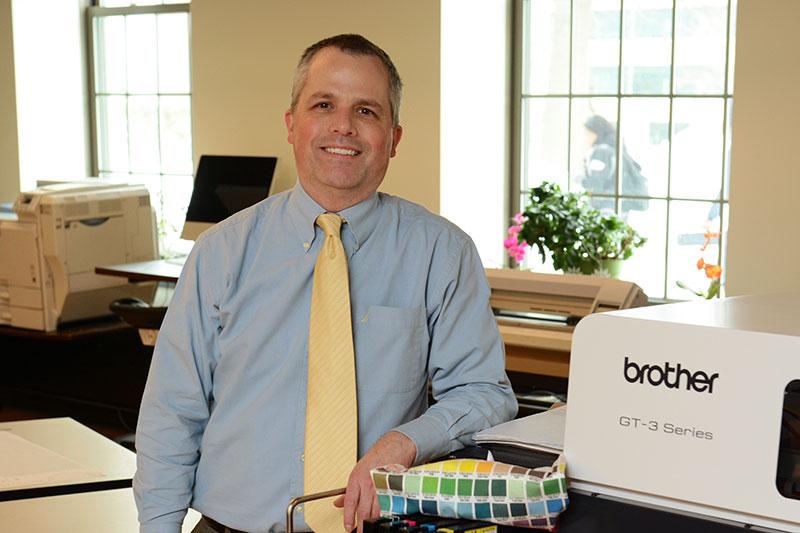Mark Springston nurtures creativity in future technologists, teachers
In this issue’s Spotlight, meet Mark Springston, an associate professor of technology and a proponent of the Maker Movement, which helps explain the proactive contributions he has made to the department and its technology education students.
Q. Where were you born and raised?
A. I was born in Harrisonburg, Virginia, but my formative years were in Hinton, West Virginia.
Q. What is your educational background?
A. One of the things I tell people is that I was at Virginia Tech in three different decades, but I wasn’t there FOR three decades. (Laughs.) I got my undergraduate degree there in the late ‘80s, my master’s in the ‘90s, and in the early 2000s, I received my Ph.D. from Virginia Tech. My dissertation was on teamwork and technological problem-solving.
Q. When and why did you come to SUNY Oswego?
A. I came here in 2006. Of course, I knew the reputation of SUNY Oswego—this program has a long history of graduating people who have gone on to do great things in education and industry. One interesting connection between here and Virginia Tech is that my former supervisor, Mark Sanders, chair of my dissertation committee, got his undergrad here.
Q. What courses do you teach?
A. The new class that I created is called “Computing Technology and Information Systems for Technology Careers.” Also “Communication and Multimedia Systems”—sometimes graduate electives in this area—and the teaching methods class that majors take just before they student teach, and the graduate assessment course.
Q. What aspect of technology do you enjoy teaching the most?
A. I really enjoy helping students create and problem-solve with the computer. Lots of them see themselves as users of the computer versus creating something meaningful with it. Certainly there’s the design component, but I also like to take students who normally wouldn’t do some things like HTML and CSS coding, and show them that it is understandable, whether or not they go on to do something more in-depth with them.
Q. What characterizes your approach to teaching?
A. I try to provide a very meaningful problem-solving experience for students. I try to challenge them to look at things in other ways. I use a lot of collaborative learning exercises—I find students learn so much from each other. In some courses, like teaching methods, I do more of a teamwork experience, because I find they can build off of each other’s ideas and it helps develop their confidence that they’re not totally by themselves in the classroom.
Q. How does that play out at the Youth Technology Day you founded?
A. With the teaching methods students, almost every semester, we invite in 60 to 80 middle school or high school students and my students design multiple 90-minute technological activities, and they team-teach them. It also helps them learn there’s a lot that has to happen before they step into the classroom.
Q. Can you recall a vivid example of a Youth Technology Day lesson?
A. There are so many ... (For example) our students had visiting students slice a piece of Styrofoam in the shape of a small wing, and then had them walk behind the wing with pieces of cardboard, and because of the way the air is flowing, it makes the wing hover right above the cardboard about 8 inches. To see the students’ faces ... it’s kind of magical. I think for the methods students to realize that the younger students appreciate the experience they planned is an important message for them to get.
Q. You also founded the STEM 4 Kids, a four-evening program?
A. I suggested, as adviser to OTEA (Oswego Technology Education Association), that it would be a way to get younger students here. It’s just taken off. Last semester, we opened registration for STEM 4 Kids, and within 24 hours we had 24 children signed up. We also have Young Inventors for fourth- through sixth-grade levels. The methods students are planning the sessions, but now the earlier classes in education are coming to assist, which somewhat places our methods students in the role of cooperating teachers.
Q. Are you still active with the 75-year-old Technology Fall Conference?
A. I served as co-chair for a couple of years and I’m now program chair for the fourth year. One thing I started as co-chair was the Technology Innovation Showcase, and that’s been a big success. I wanted to create within the program a place for people to just interact, based kind of on the Maker Movement. It’s for the educators, too, but it’s a great opportunity for our students to get involved.
Q. Do you have other campus involvements?
A. I’ve served on the Information Technology Council for eight years—five years as chair. The neat thing ... is how I can discuss in class with students different issues, like how the wireless bandwidth keeps increasing based on the needs of the campus. I’m very happy about some of the recent developments, such as students’ access to LyndaCampus.com, so they can learn how to create with the different technologies. And now we have the sitewide license to Adobe Creative Cloud.
Q. What are your off-the-job interests?
A. I love to spend time with my wife and daughter. We like to travel. I walk, that’s what I do for health.
Q. What else can you tell us about your family?
A. My daughter, Liliana, is totally bilingual in Spanish and English. She’s 9. My wife, Patricia, is from Colombia, South America. She is a registered nurse who works at Oswego Hospital. My father’s side of the family has produced a family magazine (all but three years) since the 1940s, called The Stanard Salute. My grandmother was a Stanard. We have a family reunion in Summersville, West Virginia, every five years.




